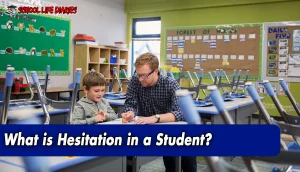It is not uncommon for students to experience hesitation in their learning journey. Student hesitation refers to the reluctance or uncertainty that students may feel when participating in classroom activities or expressing their ideas. This can hinder their ability to fully engage and contribute to the learning process.
There are various factors that can contribute to students feeling hesitant in the classroom. These may include fear of failure, lack of confidence in their abilities, fear of judgment from peers or teachers, or even a negative past experience that has impacted their self-esteem. When students hesitate, they may hold back from asking questions, sharing their thoughts, or actively participating in group discussions.
What is Hesitation in a Student?
Student hesitation in a student refers to the temporary reluctance or uncertainty displayed when faced with academic tasks or challenges. It is a common phenomenon that can hinder students’ progress and prevent them from reaching their full potential. Overcoming hesitation can be challenging, but there are three discussion ideas that can help students build their self-confidence.
Hesitation in students can impede their progress but implementing certain strategies can help them build self-confidence. Effective feedback provides guidance for improvement; cultivating a growth mindset encourages resilience; and creating a safe learning environment fosters risk-taking behavior. By addressing these discussion ideas within classrooms, teachers can empower hesitant learners to embrace challenges with confidence and achieve academic success.
What Causes Students to Feel Hesitant in the Classroom?
Apprehension, often stemming from unfamiliarity with the subject matter or fear of making mistakes, can contribute to a student’s reluctance to actively participate in classroom discussions. When students encounter new concepts or topics that they are not familiar with, they may feel hesitant to speak up and share their thoughts for fear of sounding ignorant or being judged by their peers. They may worry about giving incorrect answers or saying something that could be perceived as silly, leading them to remain silent instead.
This student hesitation can have a significant impact on a student’s learning experience. When students are reluctant to participate in class discussions, they miss out on opportunities to clarify their understanding and deepen their knowledge. Classroom discussions provide valuable opportunities for students to engage with the material, ask questions, and learn from their peers’ perspectives. By hesitating to join these conversations, students limit their own learning potential and hinder their ability to fully grasp the subject matter.
Incorporating activities that allow for small-group discussions or pair work can also help reduce student hesitation among students. Working in smaller groups allows students to engage with their peers in a less intimidating setting before participating in larger class discussions. Teachers can gradually scaffold these activities so that over time, students gain confidence in sharing their thoughts openly.
How can I Build Students’ Self-Confidence in the Learning Process?
To foster a positive learning environment, it is important to nurture students’ self-confidence in their abilities and the learning process. Building resilience is key in helping students develop a strong sense of self-confidence. By encouraging them to face challenges and persevere through difficulties, they learn that failure is not an indication of their worth or intelligence, but rather an opportunity for growth and improvement.
Promoting a positive learning environment is crucial for enhancing students’ self-confidence. Creating a classroom culture where all ideas are valued and respected helps students feel safe to express themselves without fear of judgment or ridicule. Teachers can encourage collaboration among peers, fostering an atmosphere of mutual support and encouragement. Additionally, recognizing and celebrating individual achievements can boost students’ confidence in their abilities.
Empowering students with the belief that they have control over their own success instills a sense of agency and motivation within each student. As educators strive towards these goals, they create an environment where every student feels valued, capable, and empowered to reach their full potential.
10 Tips to Cover Student Hesitation
One effective strategy for addressing student hesitation in the learning process is to create a supportive and inclusive classroom environment. Building resilience is key in helping students overcome student hesitation. By providing opportunities for students to challenge themselves and step out of their comfort zones, they can develop the confidence needed to tackle difficult tasks. This can be achieved through assigning group projects or presenting real-life scenarios that require problem-solving skills.
Some individuals may be more hesitant due to a lack of understanding or difficulty grasping certain concepts. By implementing visual aids, hands-on activities, or interactive discussions, teachers can engage students in different ways and provide multiple avenues for comprehension. This not only boosts their understanding but also empowers them with different tools they can use when facing challenges in the future.
How can I Incorporate Peer Support to Overcome Hesitation?
Incorporating peer support into the learning process can be an effective strategy for overcoming student hesitation and fostering a collaborative environment. Peer collaboration provides students with the opportunity to engage in group discussions and learn from one another’s experiences. One way to incorporate peer support is through structured group activities or projects that require students to work together towards a common goal. These activities not only encourage collaboration but also provide a supportive environment where students can learn from each other’s strengths and weaknesses.
Incorporating peer support through peer collaboration, group discussions, and mentoring can help overcome student hesitation in the learning process. By creating a collaborative environment where students feel supported by their peers, they are more likely to actively participate in class discussions and express their thoughts without hesitation. The use of structured group activities, mentorship programs within groups, and peer feedback sessions all contribute towards fostering this supportive atmosphere that encourages freedom of expression among students.
Can Extracurricular Activities Play a Role in Reducing Hesitation?
Extracurricular activities have the potential to mitigate student hesitation by providing them with opportunities for personal growth and development outside of the traditional classroom setting. These activities, such as sports, music, and drama, play a significant role in reducing hesitation among students. Participating in sports can enhance self-confidence and teamwork skills, allowing students to overcome their fears of failure or judgment.
Sports can be particularly effective in reducing student hesitation. Through participation in team sports or individual athletic pursuits, students learn valuable life skills such as discipline, perseverance, and resilience. These qualities not only contribute to improved physical health but also help build mental strength and confidence. Overcoming challenges on the field or court allows students to conquer their fears of failure and take risks without hesitation.
Music is another extracurricular activity that can significantly reduce student hesitation. Learning an instrument or participating in a choir provides an outlet for emotional expression and creativity. Students who engage in musical activities often gain confidence through performing before others or exploring different genres of music. By mastering complex techniques or composing original pieces, they develop a sense of accomplishment that translates into greater self-assurance overall.
Conclusion: 10 Teaching Tips To Cover Student Hesitation
In conclusion, student hesitation is a common issue in the classroom that can hinder learning and academic progress. Various factors such as fear of failure, lack of self-confidence, and unfamiliarity with the subject matter contribute to this hesitation. However, there are several strategies that educators can employ to address this issue. By creating a positive and inclusive learning environment, providing constructive feedback, and setting achievable goals, teachers can help build students’ self-confidence.
Additionally, extracurricular activities provide opportunities for students to explore their interests and talents outside of the traditional classroom setting, which can boost their confidence and reduce student hesitation.
Overall, by implementing these teaching tips and strategies effectively, educators have the power to cover student hesitation and create an environment where all learners feel empowered to actively engage in their education without fear or reservation.
This will not only enhance students’ academic performance but also foster their personal growth and development as confident individuals ready to face future challenges.










